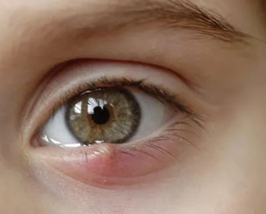A 10-year-old girl with a red bump and swelling on the lower eyelid
What is your diagnosis?

The diagnosis is...
![]()

The image is consistent with a diagnosis of a hordeolum (also known as a stye).
- A hordeolum is an acute purulent inflammation of a gland within the eyelid, analogous to a pimple on the skin.
- Hordeola can be categorized by location:
- External: inflammation of an eyelash follicle (or associated gland of Zeis or Moll)
- Internal: inflammation of a meibomian gland
- Risk factors include:
- Poor hygiene: such as frequent touching of the face without handwashing, or improper makeup removal
- Chronic conditions: such as diabetes, seborrheic dermatitis, meibomian gland disease, blepharitis, or rosacea
What is the role of the primary care or emergency medicine physician?
![]()
- Provide conservative treatment, such as using warm compresses, washing the eyelid with a gentle soap, and possibly adding topical antibiotics.
- Follow up with the patient in a few days or weeks to ensure that the patient is appropriately responding to treatment.
- Refer the patient to an ophthalmologist:
- if concerned for other conditions such as cellulitis or sebaceous cell carcinoma (in adults)
- if the stye is large or chronic (chronic styes are also known as )
What is the role of the ophthalmologist?
![]()
- Perform a slit-lamp examination.
- Monitor the patient for possible preseptal cellulitis.
- Assess for and rule out other conditions on the differential such as sebaceous cell carcinoma (in adults), cellulitis, or cysts.
- Perform incision and drainage for larger styes or chalazia.
What is the treatment?
![]()
- Conservative treatment:
- frequent warm compress use
- washing the eyelid with a gentle soap
- antibiotic (+/- steroid) ointment (this requires monitoring of eye pressure)
- For non-resolving styes (chalazia):
- Oral antibiotics may be needed if there is secondary infection of the eyelids (preseptal cellulitis)
Learn more: Ophthalmology resources for medical students
![]()